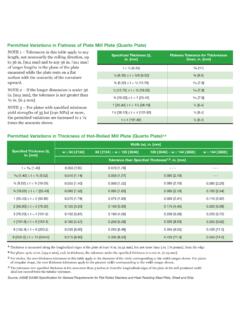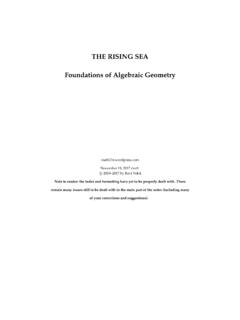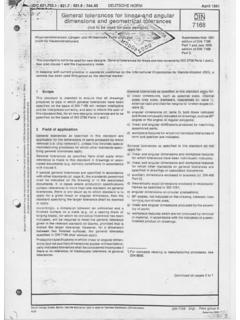Transcription of Floor Flatness and Levelness Testing - The Complete ...
1 Structural Services, Inc. Page 1 of 4 Floor Flatness and Levelness Testing The Complete Specification By Wayne W. Walker, , ; Jerry A. Holland, , ; Cecil L. Bentley, Sr; Eldon (Tipp) G. Tipping, , ; Rick E. Smith, ; and Bryan M. Birdwell There is an industry need to have a Floor Flatness and Levelness Testing specification that can be provided to the Testing agency to direct how the Testing is to be done and require the necessary communications that have to occur with all parties in order to produce a successful Floor surface. This need is exacerbated due to the lack of industry standards regarding how the Testing is to be performed, the absence of industry certifications for the personnel performing the Testing , and the many industry misconceptions that have confused even otherwise knowledgeable Testing agencies.
2 Attached is a Complete specification that can be provided to the Testing agency concerning how to perform the Testing and provide the detailed reporting and communication requirements that should occur with today s projects. The specification includes a flowchart that summarizes how the Testing and communications with all parties should occur. Below we will try to clear up some of the more prevalent industry misconceptions concerning this Testing , along with our commentary addressing some of the requirements in the specification. Industry Misconceptions Some of the industry misconceptions for Floor Flatness and Levelness are the following: 1. The ASTM that directs how the FF and FL values are to be collected and calculated is ASTM E1155 - Standard Test Method for Determining FF Floor Flatness and FL Floor Levelness Numbers (Ref.)
3 1). Many architectural and engineering firms just specify ASTM E1155 and think that is all that is required (and/or specify ACI 301 and ACI 117 see discussion below), which is not correct. This ASTM E1155 primarily addresses how to calculate the FF and FL values but does not address how a test surface is to be divided into different test sections (other than a minimum sample measurement line length and area) nor does it address the specified overall values (SOV) or minimum local values (MLV). These items should be addressed in the project specification. 2. A single sample measurement line length is not sufficient to establish a local minimum value. MLV represent test section areas of the slab and therefore cannot be defined by results of a single line measurement.
4 Unfortunately, papers that promote this misconception have been published with this misconception (Ref. 2); this information was later corrected by a letter to the editor along with other articles (Ref, 3 & 4). 3. Industry standards, such as ACI 301 (Ref. 5) and ACI 117 (Ref. 6), do not address how to divide the test surface (for SOV) into test sections (for MLV). This has caused some confusion because many have assumed this issue has been addressed in the industry standards. However, this issue of how many test sections in which to divide the test surface depends on the project budget, how much data is to be collected, and the schedule time to collect the data. Therefore, because this issue is project specific, this issue should be addressed in the project specifications.
5 Below we discuss our requirements, which are based on a compromise between the amount of data one Testing person can gather, while not affecting the construction schedule, but still providing sufficient localized data to minimize the amount of slab that would have to be removed and replaced if that test section did not meet the MLV. 4. ASTM E1155 and other industry standards do not specify the equipment accuracy for measuring the slab surface changes. The equipment accuracy should be stated in the project specifications. Structural Services, Inc. Structural Services, Inc. Page 2 of 4 Specification Commentary The attached specification is based on many years of measuring and troubleshooting Floor Flatness and Levelness issues on different types of projects.
6 The following is commentary and background information regarding some of our specification requirements. 1. We have changed the definition of test surface from ASTM E1155 s entire Floor to The entire day s of continuous concrete slab placement . Contractors have taken advantage of ASTM E1155 s definition when placing slab portions with marginally low FF/FL values and then placing slabs with exceptionally high values of FF/FL, such that the average FF/FL will equal or exceed the SOV. This issue becomes more pronounced with large buildings, where a Floor area as large as 1 million square feet or more might have significant slab areas with marginal MLV values of FF/FL.
7 In our specification, by changing the definition of test surface this issue is minimized, especially with today s equipment where daily slab placements of 20,000 sf to 50,000 sf are common. 2. As mentioned above, there is no industry standard certification for personnel who perform the Testing . We have seen the competency level of the Testing personnel vary substantially; this includes some Testing personnel who have read the equipment manual and rely on the software to do the Testing correctly but have little fundamental understanding of the Testing procedure. The major Testing equipment manufacturers do provide certification training on how to operate their Testing equipment and perform the Testing .
8 To have a minimum level of Testing personnel competency, we have required the Testing personnel to have attended and successfully completed the training provided by the manufacturer of their particular equipment and to submit their certification. In the future, we hope to encourage ACI to develop and offer a F-Number Certification Program and then require ACI Certified Technicians in ACI 301. 3. We have added additional reporting requirements above the ASTM E1155 minimal requirement of listing the FF/FL values in a tabular form. These requirements are necessary to help the contractor improve and troubleshoot issues when FF/FL values are low. These requirements are: A. Provide a Floor plan showing the boundary limits of each test section, along with the locations of the sample measurement lines, such that the deficient areas can be located.
9 The plan should be sufficiently accurate to allow the Testing to be replicated and data to be verified if necessary. B. Provide a plot or graph of the sample measurement lines, along with the maximum q value (profile curvature value). This graph and q value can be used to determine if there are anomalies that are being averaged out , with the result that acceptable FF/FL values are being reported even though localized problems may be present. Additionally, we take exception to ASTM E1155 s two foot exclusion requirement for construction joints by requiring the sample measurement lines to start at the construction joint; we do this because these locations are often the worst portions of the slab due to different finishing tools and techniques and also because vehicles, personnel, etc.
10 Do not avoid these joints. By starting the sample measure lines at the construction joint, allows identification of potential construction joint elevation issues if they are occurring. 4. We have added a section concerning notifications. It is very important that the Testing agency notify all of the parties if the MLV is not achieved for a specific test section. This notification is to occur immediately after the test for that section is completed. We have even provided a Work Flowchart showing how these notifications are to occur during the Testing procedure and also the contractor s options if a test section is below the MLV. The contractor may choose to do additional Testing to possibly limit the amount of slab that has to be removed and replaced.








